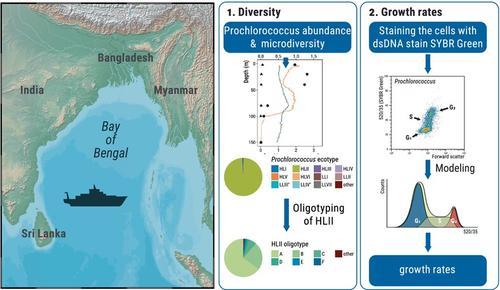当前位置:
X-MOL 学术
›
Environ. Microbiol.
›
论文详情
Our official English website, www.x-mol.net, welcomes your
feedback! (Note: you will need to create a separate account there.)
A single Prochlorococcus ecotype dominates the tropical Bay of Bengal with ultradian growth
Environmental Microbiology ( IF 4.3 ) Pub Date : 2024-03-22 , DOI: 10.1111/1462-2920.16605 Jonathan Grone 1 , Camille Poirier 1 , Kathleen Abbott 2, 3 , Fabian Wittmers 1, 4 , Gualtiero Spiro Jaeger 3 , Amala Mahadevan 3 , Alexandra Z Worden 1, 4
Environmental Microbiology ( IF 4.3 ) Pub Date : 2024-03-22 , DOI: 10.1111/1462-2920.16605 Jonathan Grone 1 , Camille Poirier 1 , Kathleen Abbott 2, 3 , Fabian Wittmers 1, 4 , Gualtiero Spiro Jaeger 3 , Amala Mahadevan 3 , Alexandra Z Worden 1, 4
Affiliation

|
The Bay of Bengal (BoB) spans >2.2 million km2 in the northeastern Indian Ocean and is bordered by dense populations that depend upon its resources. Over recent decades, a shift from larger phytoplankton to picoplankton has been reported, yet the abundance, activity, and composition of primary producer communities are not well‐characterized. We analysed the BoB regions during the summer monsoon. Prochlorococcus ranged up to 3.14 × 105 cells mL−1 in the surface mixed layer, averaging 1.74 ± 0.46 × 105 in the upper 10 m and consistently higher than Synechococcus and eukaryotic phytoplankton. V1‐V2 rRNA gene amplicon analyses showed the High Light II (HLII) ecotype formed 98 ± 1% of Prochlorococcus amplicons in surface waters, comprising six oligotypes, with the dominant oligotype accounting for 65 ± 4% of HLII. Diel sampling of a coherent water mass demonstrated evening onset of cell division and rapid Prochlorococcus growth between 1.5 and 3.1 div day−1 , based on cell cycle analysis, as confirmed by abundance‐based estimates of 2.1 div day−1 . Accumulation of Prochlorococcus produced by ultradian growth was restricted by high loss rates. Alongside prior Arabian Sea and tropical Atlantic rates, our results indicate Prochlorococcus growth rates should be reevaluated with greater attention to latitudinal zones and influences on contributions to global primary production.
中文翻译:

单一的原绿球藻生态型在热带孟加拉湾以超电生长为主
孟加拉湾 (BoB) 跨度超过 220 万公里2位于印度洋东北部,毗邻依赖其资源的密集人口。近几十年来,已有报道称浮游植物从大型浮游植物转向超微型浮游生物,但初级生产者群落的丰度、活动和组成尚不清楚。我们分析了夏季季风期间的 BoB 区域。原绿球藻属范围高达 3.14 × 10 5细胞毫升−1表面混合层,平均1.74±0.46×10 5在上部 10 m 并始终高于聚球藻属和真核浮游植物。 V1-V2 rRNA 基因扩增子分析显示,98 ± 1% 形成 High Light II (HLII) 生态型原绿球藻属地表水中的扩增子,包括六种寡型,其中占主导地位的寡型占 HLII 的 65 ± 4%。对连贯水团的昼夜采样表明,细胞分裂是在晚上开始的,并且细胞分裂速度很快。原绿球藻属增长 1.5 至 3.1 div 天−1 ,基于细胞周期分析,并通过 2.1 div 天的基于丰度的估计得到证实−1 。累积原绿球藻属超电增长所产生的产量受到高损失率的限制。除了之前的阿拉伯海和热带大西洋费率之外,我们的结果表明原绿球藻应重新评估增长率,更多地关注纬度区域及其对全球初级生产贡献的影响。
更新日期:2024-03-22
中文翻译:

单一的原绿球藻生态型在热带孟加拉湾以超电生长为主
孟加拉湾 (BoB) 跨度超过 220 万公里2位于印度洋东北部,毗邻依赖其资源的密集人口。近几十年来,已有报道称浮游植物从大型浮游植物转向超微型浮游生物,但初级生产者群落的丰度、活动和组成尚不清楚。我们分析了夏季季风期间的 BoB 区域。原绿球藻属范围高达 3.14 × 10 5细胞毫升−1表面混合层,平均1.74±0.46×10 5在上部 10 m 并始终高于聚球藻属和真核浮游植物。 V1-V2 rRNA 基因扩增子分析显示,98 ± 1% 形成 High Light II (HLII) 生态型原绿球藻属地表水中的扩增子,包括六种寡型,其中占主导地位的寡型占 HLII 的 65 ± 4%。对连贯水团的昼夜采样表明,细胞分裂是在晚上开始的,并且细胞分裂速度很快。原绿球藻属增长 1.5 至 3.1 div 天−1 ,基于细胞周期分析,并通过 2.1 div 天的基于丰度的估计得到证实−1 。累积原绿球藻属超电增长所产生的产量受到高损失率的限制。除了之前的阿拉伯海和热带大西洋费率之外,我们的结果表明原绿球藻应重新评估增长率,更多地关注纬度区域及其对全球初级生产贡献的影响。











































 京公网安备 11010802027423号
京公网安备 11010802027423号